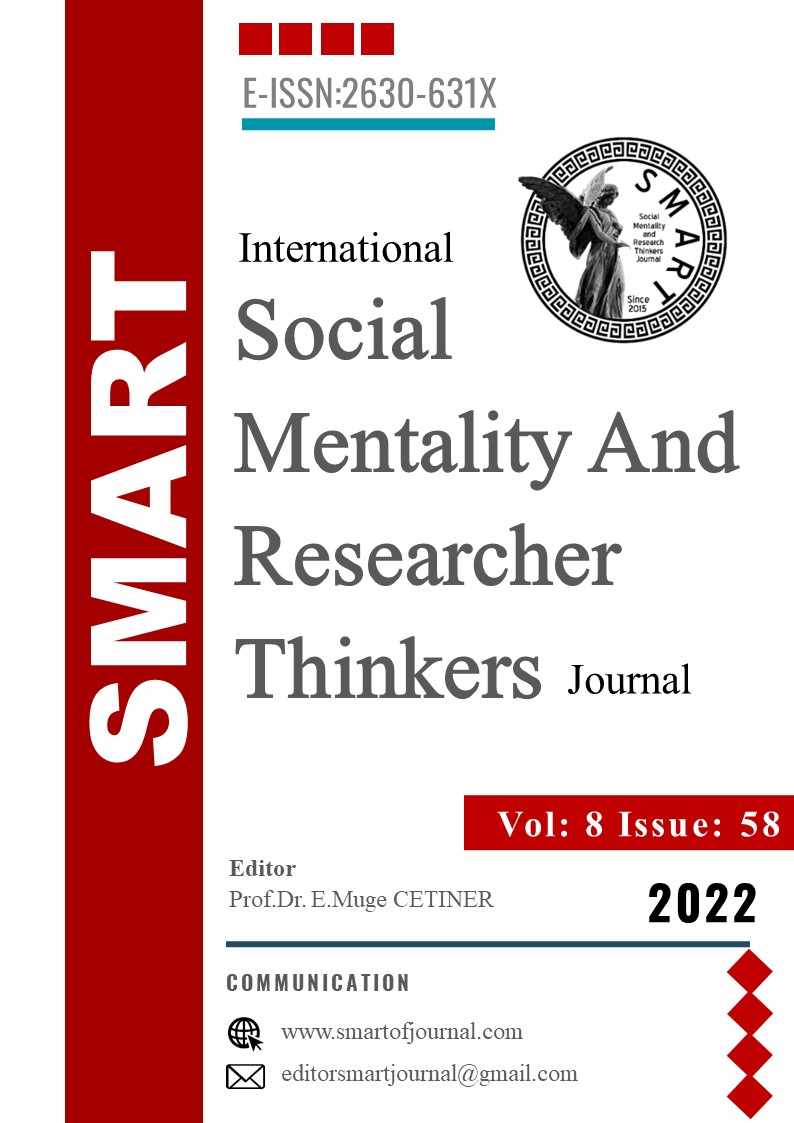Author :
Abstract
Cumhuriyetle birlikte Türkiye çok önemli ve köklü bir değişim süreci içerisine girmiştir. Yaşanan siyasal, kültürel değişiklilerin yanında ülkenin sahip olduğu insan gücü, bunun niteliği gibi demografik unsurlar hakkında envanterlerin yapılması gerekliliği de ortaya çıkmıştır. Çünkü nüfus hareketleri, göç ve kentleşme gibi sosyal olgular üzerine politikalar üretebilmek hiç kuşkusuz eldeki demografik verilerden hareketle yapılacaktır. Türkiye Cumhuriyeti, imparatorluktan ağır bir demografik yapıyı miras almış; bir yandan hastalık ve yoksullukla boğuşurken, bir yandan da art arda gelen savaşlar nedeniyle erkek nüfusunda ciddi bir azalma olmuş, bütün bu olumsuz koşullara bir de cephedeki uzun kalma süreleri eklenince evlilik ve doğurganlık hızında gerileme yaşanmıştır. Doğaldır ki bu durum bize, üretici yaş grubunun gerilemesine koşut olarak bağımlı nüfus sayısının arttığını, bu da toplumdaki üretim-tüketim dengesinin bozulduğunu göstermektedir. Nüfus açıklarını telafi etmek ve düşük yoğunlukta da olsa ülke topraklarını besleyerek kalkınmanın itici unsuru olacak bir nüfus kaynağı oluşturmak, Cumhuriyet’in ilk dönemlerinde belirlenen ana politikadır. Bu politika gereği nüfusu artırmanın yolu bir yanıyla ölümlerin düşürülmesiyken, diğer yanıyla da doğumların artırılmasıdır. Bu politikanın başarılı bir biçimde hayata geçirilmesi toplum içinde yüksek doğurganlık eğilimini hızlandırmış, böylece ülke nüfusunun da hızla büyümesini sağlamıştır.
Keywords
Abstract
With the Republic, Turkey entered into a very important and radical change process. In addition to the political and cultural changes experienced, the necessity of making inventories about demographic factors such as the manpower of the country and its quality has emerged. Because, to be able to produce policies on social phenomena such as population movements, migration and urbanization will undoubtedly be based on the demographic data at hand. The Republic of Turkey inherited a heavy demographic structure from the empire; While struggling with illness and poverty on the one hand, there was a serious decrease in the male population due to the successive wars, on the other hand, when the long stays at the front were added to all these negative conditions, there was a decline in the rate of marriage and fertility. Naturally, this situation shows us that the number of dependent population has increased in parallel with the decline of the producer age group, and this shows that the production-consumption balance in the society has deteriorated. Compensating for the population deficits and creating a population source that will be the driving factor of development by feeding the country's lands, albeit at low density, was the main policy determined in the early years of the Republic. As a requirement of this policy, the way to increase the population is on the one hand to decrease the deaths and on the other hand to increase the births. The successful implementation of this policy accelerated the high fertility trend in the society, thus enabling the country's population to grow rapidly.
Keywords
- Aksoy, E. (2016). “1919-1955 Yılları Arasında Türkiye’nin Nüfus Yapısı ve Uygulanan Nüfus Politikaları”,
- Aksoy, E. (2016). “1919-1955 Yılları Arasında Türkiye’nin Nüfus Yapısı ve Uygulanan Nüfus Politikaları”, Türkiyat Araştırmaları Dergisi, Sayı 24, ss:27-44
- Aktel, M. & Saydam, S. (2019). “Türkiye’de Askeri Darbe Dönemlerinde Nüfus Politikalarına YönelikDüzenlemeler”, Mehmet Akif Ersoy Üniversitesi Sosyal Bilimler Enstitüsü Dergisi, Cilt:11, Sayı:30, Aralık, ss.764-783
- Çakıcı, N. (2014). “Trabzon’un Demografik Yapısı (1923-1950)”, Yayınlanmamış YL Tezi, KTÜ Sosyal Bilimler Enstitüsü, Trabzon
- Çakmak, F. (2007). “Atatürk Döneminde Türkiye’nin Nüfus Politikası”,Yayınlanmamış YL Tezi, Dokuz Eylül Üniversitesi, AİİTE, İzmir.
- Çakmak, F. (2009). “Cumhuriyet’in İlk Yıllarında Nüfusu Kayıt Altına Almaya Yönelik Girişimler”, CTTAD, VIII/18-19, ss: 89-115.
- Die (2010). İstatistik Göstergeler 1923-2009, Türkiye İstatistik Kurumu(TÜİK), Yayın no 3493, Ankara.
- Duman, Ö. (2008). “Atatürk Döneminde Romanya’dan Türk Göçleri (1923-1938)”, Bilig, Sayı 45, ss: 23-44.
- Gökburun, İ. (2020). “Türkiye’nin Demografik Dönüşüm Sürecinde Nüfus Politikalarının Rolü”, Gelecek Vizyonlar Dergisi, 4 (Coğrafya Özel Sayısı), ss: 1-15.
- Gümüş, İ. (2018). Türkiye’nin Nüfus Yapısı, AYKAÇ,Mustafa (Der).,Türkiye’nin Toplumsal Yapısı içinde (197-216), İÜAUEF, İstanbul.
- Kaypak, Ş. (2014). “Atatürk’ün Kent Ve Kentleşmeye Bakışı; Örnek Olay: Ankara’nın Kentleşmesi”, Mustafa Kemal Üniversitesi Sosyal Bilimler Enstitüsü Dergisi, Cilt: 13, Sayı:27, ss.349-365.
- Oktay, E. Y. (2014), “Türkiye’de Cumhuriyet’in İlanından Günümüze Uygulanan Nüfus Politikaları”, Yalova Sosyal Bilimler Dergisi, Sayı 7, ss: 31-54
- Özdoğan, İ. (2019), “Ağrı İlinin Cumhuriyet Dönemi Nüfus Seyri (1923-2018)”, Ağrı İbrahim Çeçen Üniversitesi Sosyal Bilimler Enstitüsü Dergisi, Sayı: 5, ss: 177-206.
- Sağlam, S. (2016). 1923-1950 Yılları Arasında Türkiye’de Kent ve Kentleşme Olgusu, Sosyoloji Konferansları (Editör: N. Güngör Ergan), Sayı 53, ss: 257-274
- Sertkaya Doğan, Ö.& Bostan, H. (2019). “Türkiye’nin Demografik Dönüşümü ve Nüfus Projeksiyonlarına Göre Fırsatlar”, Doğu Coğrafya Dergisi, Cilt 24,Sayı 41, ss: 61-90
- Tamer, A.& Bozbeyoğlu, A. Ç. (2004). “1927 Nüfus Sayımının Türkiye’de Ulus Devlet İnşasındaki Yeri: Basında Yansımalar”, Nüfusbilim Dergisi, Sayı 26, ss: 73-88
- Tekeli, İ. (1998), Türkiye’de Cumhuriyet Döneminde Kentsel Gelişme ve Kent Planlaması, 75 Yılda Değişen Kent ve Mimarlık içinde, Tarih Vakfı Yayınları, İstanbul.
- Ural, S. & Arslan, N. (2016), “Atatürk Dönemi Iğdır’da Nüfus Sayımları”, Kafkas Üniversitesi Sosyal Bilimler Enstitüsü Dergisi, Sayı1, ss: 503-529.
- Yılmaz, E. & Çitçi, S. (2011). “Kentlerin Ortaya Çıkışı ve Sosyo-Politik Açıdan Türkiye’de Kentleşme Dönemleri”, Elektronik Sosyal Bilimler Dergisi, Cilt 10, Sayı 35, ss: 252-267





